
Pulp Mill Covered Bridge Repairs - 2002
[WGN 45-01-04]

Pulp Mill Repairs Index
- Pulp Mill Bridge Closed For repairs: June 24, 2002
- Pulp Mill Bridge Closed For repairs. Again: June 30, 2002
- Work Continues on the Pulp Mill Bridge: July 11, 2002
- Work On The Pulp Mill Bridge Nears Completion: August 14, 2002
- Middlebury's Pulp Mill Bridge Reopened: August 23, 2002
- Some Commentary On The Pulp Mill Bridge: September 18, 2002
Pulp Mill Bridge Closed For repairs
June 24, 2002 - Joe, I stopped by the Pulp Mill Bridge this noon to say hi. Paul Ide gave me a brief synopsis of the structural problems with the bridge. As I understand it (aside from rot etc. (how much, I don't know) the issues are because of the improper "fixes" of bottom chords in past "repair" attempts. The tension bottom chords are sistered and improperly done.
I took a few photos at a site cut out of the deck which will show a huge plate bolted over one of these joints by about 7 or 8 bolts each. Paul says the holes bored to accommodate the bolts were drilled way too large, probably to allow for ease of bolt installation. The sistered joint I could see had slipped several inches. Paul says there are eight, maybe ten, of these plated sistered bottom chord joints and the entire mess must be corrected--the dollars not being there and, of course, piece-meal work only adds to the cost of repair.
The arch only adds to the dead load, said Paul Ide: when the two piers were installed it should have been removed and the bridge left as three multiple kingpost spans.
Boy, is traffic a mess in Middlebury with one bridge in use!
Irene Barna
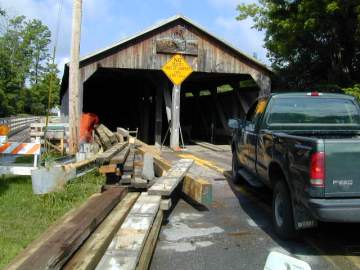
June 28, 2002
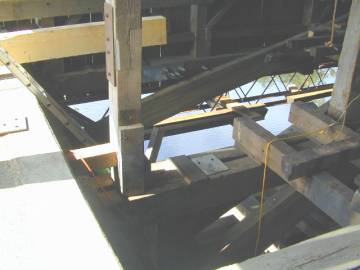
June 28, 2002
Pulp Mill Bridge Closed For repairs. Again.
June 30, 2002 - Hi Joe, we continue to undo the results of a bad repair in the 1980's. The bridge itself, although one of the oldest in the state and justly famous, has been in trouble since the day it was built.
Examination of the structure shows that the Pulp Mill Bridge was originally a single span of nearly 200 ft., probably based upon the numerous double barreled Burr variants around at the time. A crucial mistake was made in its original construction however when the posts, which both act in tension and accept a horizontal thrust from the main braces, were not shouldered into the chords, but merely affixed with a single square bolt. The load on the braces quickly began to break these posts across the bolts leading the bridge to sag and to drastic solutions such as the addition of arches and the subdivision of the bridge into three spans, with the necessary reversal of half the bracing.
We are working on the middle truss of the north span, rebuilding the chord, staggering joints, adding shear blocks and shouldering and check braces et. al.
Jan Lewandoski
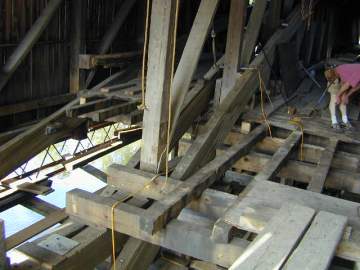
June 28, 2002

June 28, 2002
Work Continues on the Pulp Mill Bridge
July 11, 2002 - Work on the Middlebury/Weybridge Pulp Mill Bridge Continues. With a start date of June 10, the span is scheduled to reopen August 9.
The old "double-barrel" bridge stands in a tight little urban neighborhood. Its importance to the neighborhood and the larger community becomes evident when the bridge is closed--the towns usual traffic patterns are disrupted as bridge users crowd alternate routes.
The Pulp Mill is the only two-lane covered bridge in Vermont that carries regular daily traffic. Vermont s other two-laner originally served Cambridge. It now stands next to Route 7 in Shelburne and is used as an entry for staff at the Shelburne Museum. This tally does not count Windsor's two-laner over the Connecticut River, because 99% of it is in New Hampshire.
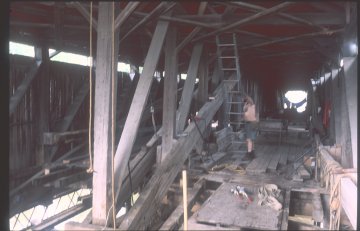
June 28, 2002
Work continues on the middle truss of the west span, rebuilding the chord, staggering joints, adding shear blocks, shouldering, and check braces.
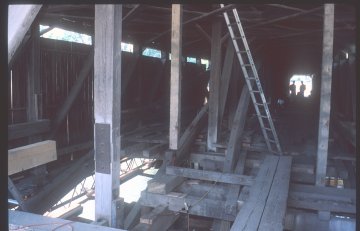
June 28, 2002
As work progresses on the middle truss of the "double-barrel bridge," the roadway is taken up to gain access to the middle chord. Access is incidentally gained to the outside truss chords also in need of work. However, funds and the contract cover only the middle truss.
The 184-foot Pulp Mill Bridge once crossed the Otter Creek with a single span. According to the Vermont Agency of Transportation covered bridge inspection report, the two concrete piers topped with timber cribs we see today were built in 1979. When the bridge was subdivided into three spans, the direction of half the braces had to be reversed. The stone abutments were capped and faced with concrete and the laminated arches rebuilt. Additional work was done in 1991 by Jan Lewandoski.
According to Mr. Lewandoski, when the Pulp Mill bridge was constructed, the builders overlooked several key details. The posts, which receive heavy braces, don't shoulder within the chords. That is, the notched posts aren't fitted into lower chord members notched to receive them, latching them in place. Instead, the bottoms of the posts are reduced in thickness to fit between the chord members and held there with a single bolt. The tremendous load of the nearly two-hundred- foot-long span transmitted through the braces set at the bottoms of the posts would break the posts, sliding them between the chord members. The bridge started failing right away, and carpenters have been fixing it ever since.
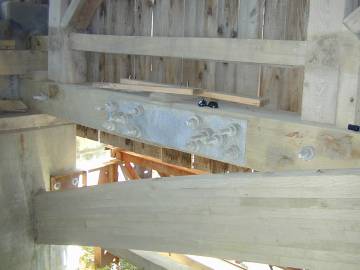
July 11, 2002
The large metal plate on the upstream chord is a splice installed by the State in the 1980s. This view also details one of the laminated arches at the west abutment.
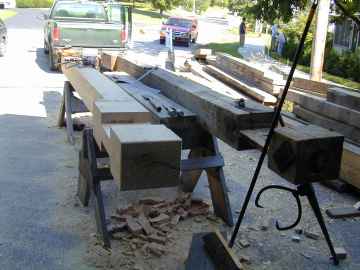
July 11, 2002
The new and the old -- The kingpost on the right, part of the original construction, was lap-cut to fit between the lower chord-members secured only by one bolt. The original chords were not lapped to provide shoulders to lock the kingposts in place.
Early efforts were made to strengthen the truss with Burr-style segmented timber arches--when the arches were added is uncertain. In the 1860s these were augmented with laminated arches of three-inch planks, using the original arch as a form.
Today, there are two large arches between the lanes that rise nearly to the ridge pole. A smaller arch rises to the eaves on each side. The center arches, consisting of a lamination of ten three-by six-inch planks, are bolted to both sides of a central multiple-kingpost truss. The outer arches are a lamination of nine three-by six-inch planks each bolted to the inside of a multiple-king post truss. There is no longer any evidence of the original segmented timber arches.
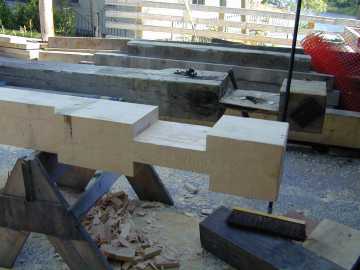
July 11, 2002
A close-up of the kingposts, new vs. the original. The original lap-cut left very little material where the post passes between the chord-members.
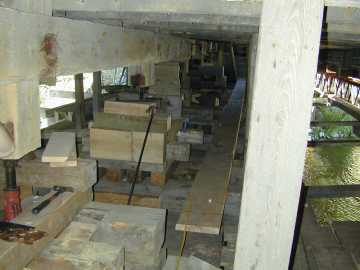
July 11, 2002
A view of the center chord system. The truss chord members here are being reworked to provide needed shouldering for the kingposts. The knob-ends of two kingposts can be seen here.
There is access to the creek at the southeast side of the bridge approach. From there, at low water, the entire length of the bridge with piers and abutments can be viewed from the dam. Note that the ends of the arches are bedded in the abutments below the main stringers. Most of the other Vermont bridges built in the "Burr manner" terminate the ends of the arches at the bottom chords above the abutments.
Besides being on the National Register of Historic Places, the Middlebury town plan identifies the bridge as a Scenic Roads Resource, giving it additional preservation status. The Town of Weybridge was awarded a grant to fund the pedestrian bridge beside the covered bridge.
The Pulp Mill Bridge was named for a wood-pulp mill that operated nearby. It is located on Weybridge Road on the Weybridge-Middlebury town line and is maintained by both towns.
(This article adapted from Spanning Time: Vermont's Covered Bridges)
Work On The Pulp Mill Bridge Nears Completion
August 14, 2002 - The signs guarding the approach roads to the Pulpmill Bridge that once promised that the bridge would be open to traffic August 9th now announces August 23rd as the big day. Asked about the change, Contractor Paul Ide explained that the town had given them two months to do the work and the work was on schedule. Some delay was caused by the availability of equipment needed to remove some supporting steel-work from under the bridge, said carpenter Don Estes, else the project could have been completed ahead of schedule.
The biggest problem is that the Towns of Middlebury and Weybridge, with limited funding, let the contract to repair only the center truss. The other trusses need work as well.
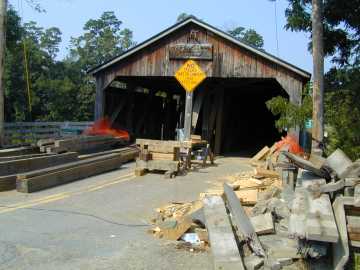
August 14, 2002
Work is nearing completion on the Pulpmill Covered Bridge. This scene will soon be livened by moving traffic.
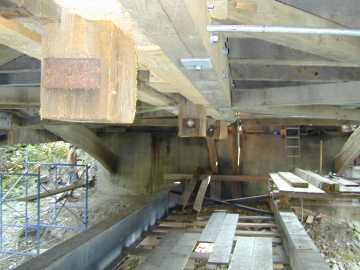
August 14, 2002
Kingpost "knobs" thrust down through the newly repaired center truss bottom chord. Note also the new diagonal braces.
Asked if they had encountered any unforseen problems, Ide replied: "We had to replace a post that wasn't planned on. The biggest hassle is we're jacking up only one truss. The other two are lower, so it's kind of self defeating hanging the other two trusses off this one. To try to push (the center truss) up and maintain any camber is impossible. So what we have really done is succeeded in strengthening the bottom chord, but it still sags. It's kind of weird if you don't do the whole thing at once."
Will the bridge take traffic safely? "Oh yes, replied Ide. "It'll take traffic. It's way better than it was. There is so much to be done here. Instead of spending 50 years and millions of dollars fixing the bridge piecemeal instead of spending a million just once. A million bucks could fix the whole thing completely."
What should be done with the bridge? "Take the arches out, which is cheap, also, it's much better for traffic because you'd have a [wider] lane to go through. The arches are dead-load, they can't be doing anything good.. I think what we really need to do is replace all of the chords to the original length, create all of the shear blocks they never had in the first place, and make shouldered joints between chord and post.
"Basically, build the bridge with the same design but better application. And much shorter distances. With the piers and the short distances between them, it'll be quite good. It'll definitely take the traffic. But you've got to do it all at once, you can't do it in parts."
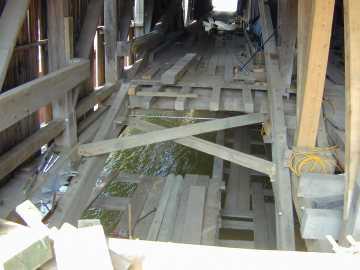
August 14, 2002
Note the new kingpost and brace to the right of the west-bound lane.
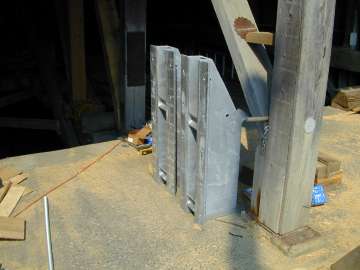
August 14, 2002
These steel brackets will hold the western ends of the center arches.
Middlebury's Pulp Mill Bridge Reopened
by Irene Barna
The Pulp Mill Bridge reopened Friday, August 23. I had stopped by in early August and spoke with Contractor Paul Ide and his co-worker. Both were quite disgruntled that they couldn't proceed until the necessary repairs were completed because much more work needs to be done.
Both craftsmen expressed the wish to remove the 1980s vintage interior arches as they only add to the dead load and do not enhance the structural integrity of the bridge. Paul said the bridge was safe for traffic but more rehabilitation work is needed. Monies, of course, aren't there and the local folks will be angry and frustrated again, in a future year, with disrupted traffic.
This kind of inconvenience to people can lead to hostility which could turn opinions against the value of the historic bridge when it is part of the traffic infrastructure when put up against the convenience of getting from point A to point B. Most don't understand the longevity of a wooden bridge vs. other materials. I spoke with people who, in their frustrations with traffic delays, "Want it moved someplace else".
Unfortunately, Pulp Mill Bridge becomes the scapegoat for the fact that it is one of only two places to cross Otter Creek in this county seat - college community bisected by the Creek. 182 years old and it still takes a lot of traffic.
Poor, valiant bridge. I traveled it yesterday. In evidence are some new timbers and some new decking at the Middlebury end and traffic. Lots of traffic!

August 14, 2002
Some Commentary On The Pulp Mill Bridge
by Jan Lewandoski
The Pulp Mill Bridge in Middlebury is possibly Vermont's oldest bridge and certainly one of its most heavily traveled. We reopened it to traffic in late August after 2 1/2 months of work rebuilding the center truss and re-footing the arch.
The Pulp Mill Bridge has a long history of problems, beginning with crucial errors in its original construction. Built around 1820 (or perhaps 1850) as a double barreled multiple kingpost with a nearly 200 foot single span, it began to fail shortly afterwards.
H. W. Congdon reports that reinforcing laminated arches were added around 1859, and R. S. Allen says it was subdivided into 3 spans long ago. The crucial flaw is that the posts were not shouldered into the bottom chord but were merely necked down to a very small size and allowed to pass through the chord. Most of the resistance to the horizontal thrust of the main braces, which is great in a span this large, was carried on a single square bolt that transfixed the chord and post at this point, and on the check braces. Not shouldering the posts also eliminates the post as a shear block to help keep the bottom chord lamina from sliding by each other in tension, and there were relatively few shear blocks elsewhere in the chords.
The subdivision of the bridge, whenever it happened, involved reversing the direction of half the main braces in the bridge and bolting new bearing shoulders for them on the opposite sides of the posts. If you walk to the center of the middle span, you can view the bridges original center kingposts, with their entasis.
While all three of the trusses in the Middlebury span (as well as the middle span and the two that I haven't yet repaired) are dramatically in need of work, there were only funds available this year for work on the center truss with its obvious problems. We swung 63-foot steel I-beams under the bridge, placed cribbing and jacks upon them and gained control of the center truss. We could only lift it to barely level because the two outer trusses were (and are) hanging below it and dragging it downward. We cut the arches out of the concrete, took the chord apart, discarded the bad work of the 1980's, introduced chord members and sisters between 38 and 49 ft. in single stick lengths with staggered joints, shear blocked all the un-shouldered post positions, replaced a damaged major post (using a 8" x 16" x 22 ft. hemlock timber), and re-footed the arch on steel thrust blocks. In addition we changed the hanger and tie rods for that truss and rebuilt much of the far too thick and heavy floor that burdens the bridge. The only thing that keeps this bridge standing are the shortness of its spans and the fact that there are three trusses. According to Gil Newbury's analysis a few years ago, only the center arches are tall enough to contribute anything to the structure. The outer ones have large negative areas and are mostly weighing down the bridge. Lets hope funds become available to fix all of this beautiful structure.
Most of the timber for my repair was spruce (the long sticks), beech and white oak. The work was carried out by Paul Ide , Don Estes, Clark McKenzie and myself, with help from Brown's Welding and Crane in Bristol.
